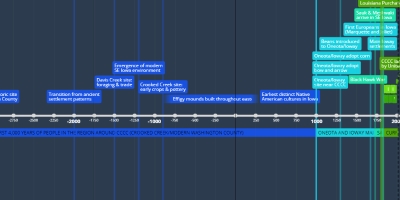1 gen 1200 anni a. C. - Emergence of modern SE Iowa environment
Descrizione:
Eastern Iowa transitions from tall-grass prairie to mixed forest & prairie by 1200 b.c.e.:Around 1200 b.c.e. is when this landscape became much the same as it is today, with rivers and creeks running between the prairie-covered hills and plains and through the abundantly wooded valleys and ravines. Archaeologists estimate that there were over 4,000 people throughout Iowa by then. Before this climatic transition, eastern Iowa had been much drier, which meant there were probably fewer waterways, and this whole region was covered by largely uninterrupted tall-grass prairies. Those vast prairies were what existed here during the time that people from the oldest archaeological sites in Washington County date to, which is 3000 b.c.e.
Well before the time those earliest communities are known to have arrived here, all of this would have been pine forests, as was the rest of eastern Iowa. At that time Iowa was inhabited by panthers, wolves, caribou, elk, moose, musk ox, and bison. There were deer then, too, which makes them perhaps the most ancient inhabitant to still populate this area today.
Horses are one of the most famous and historically significant animals to be introduced to the Americas when Europeans first came during the 16th and 17th centuries, but there was actually a native species of horse that lived here thousands of years ago until it eventually went extinct. There were also peccaries at that time, which we now associate with South and Central America, and there was even some type of camel at one point! Animals that no longer exist anywhere in the world included giant sloths and giant beavers. Mammoths and mastodons were also all over Iowa, their fossils having been found in every single county. A mammoth fossil was found less than five miles from camp in Walnut Creek, Brighton Township. The earliest people in Iowa are known to have hunted mammoths, and may well have done so here as well. During these ancient and colder times, people living among the prairies of western Iowa are believed to have been bison hunters, while people from eastern Iowa’s vast pine forests relied on gathering as well as hunting. However, mammoths and most of the other exotic animals of ancient Iowa were extinct by the time people are known to have arrived in Washington County (based on known archaeological sites as of 2013).
Aggiunto al nastro di tempo:
Data:
1 gen 1200 anni a. C.
Adesso
~ 3227 years ago
